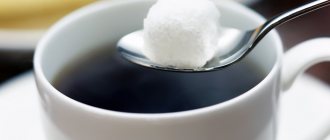Almost everyone drinks coffee. And many people think about what caloric content this drink has. Does it harm the process of losing weight if a person is on a diet? There are quite a lot of nuances here.
We need to start with the fact that different coffees have different characteristics. And the addition of all kinds of additives, such as milk, cream, syrup, etc., also affects the calorie content, the presence of protein, fats and carbohydrates (see the chemical composition of coffee).
Let's sort this out.
Calorie content of coffee (per 100 grams of product)
| Coffee type | Calories, kcal | Squirrels | Fats | Carbohydrates |
| Granular, soluble | 94 | 15 | 3,5 | 0 |
| In beans | 223 | 13,9 | 14,4 | 15,6 |
| Ground | 201 | 13,9 | 14,4 | 4,1 |
So, these are the indicators of the raw materials. Let's calculate the required values.
As you can see from these data, the lowest calorie coffee is granulated (see how freeze-dried coffee is made). Until now, many people continue to drink this drink. On average, take 2 tablespoons of coffee for one 200 ml cup. In our case, one spoon is approximately 8 grams of raw material.
As a result, we get 15 grams for one finished mug.
Conclusion - 1 cup of instant coffee contains about 14 calories
Go ahead. Let's calculate how much energy a mug of drink made from beans or ground coffee will give us.
For calculations, we will again take 2 spoons of raw materials per cup. These indicators are adhered to in most recipes - for Turkish coffee (see Oriental coffee), in coffee machines, etc. Accordingly, we will need 15 grams of coffee. We carry out simple calculations and get the result.
Conclusion.
A cup of whole bean coffee has about 33 calories. A cup of ground coffee - about 30.
You can see other indicators in the table. What can be noted. Natural bean coffee can be safely consumed before sports training (see why it is not recommended to drink a lot of coffee). They contain proteins necessary for muscle growth, as well as carbohydrates that saturate our body with energy. This is a completely acceptable energy drink.
But we completely forgot about sugar. If you add it to a ready-made drink, then add 30-32 calories per spoon. If we add 2 teaspoons to our coffee beans, our drink will end up containing about 100 calories.
Now you have everything you need for the calculation.
Harm and contraindications
Due to its high caffeine content, the drink has a stimulating effect on the nervous system. This should be kept in mind by people with increased irritability. By washing away calcium and some other beneficial substances from the body, it can contribute to the deterioration of the condition of bones, teeth, hair, and nails.
Does coffee with milk increase or decrease blood pressure? Coffee significantly increases blood pressure, but if you dilute it with milk and occasionally consume it in small doses, the harm will be much less.
Regular consumption of coffee in large doses can lead to addiction. The fact is that the drink promotes the production of the so-called happiness hormone. Under its influence, mood improves and physical activity increases. When the effect of the hormone ends, a lack of it occurs, leading to apathy and prompting you to drink the drink in even larger doses.
There is an opinion that milk neutralizes coffee. This is not entirely true: the dairy product only reduces the amount of caffeine, but the effect of the substance remains the same.
If there are no serious health problems, you can sometimes enjoy a cup of an invigorating drink, but there are people for whom coffee is contraindicated in any quantity. These include:
- Pregnant and lactating women.
- Children.
- Suffering from heart disease, increased nervous excitability, obesity, high hypertension, lactose intolerance.
How many calories are in coffee with milk?
Milk is the most popular additive to coffee. And this product is not low in calories. So that you can independently calculate the final values, you need to know what content of nutrients is in milk. Moreover, we should not forget that the numbers vary greatly depending on the fat content, and in the process of preparing the drink for sale. Below you will find everything you need.
| Type of milk | Calorie content per 100 grams | Portion 20 ml. (kcal) | Serving 50 ml (kcal) |
| Fat content 0.1% | 31 | 6 | 16 |
| Fat content 0.5% | 36 | 7 | 18 |
| Fat content 1.5% | 44 | 9 | 22 |
| Fat content 2.5% | 52 | 10 | 26 |
| Fat content 3.2% | 58 | 12 | 29 |
| Fat content 3.5% | 61 | 12 | 31 |
| Domestic cow | 64 | 13 | 32 |
| Dry whole | 476 | 95 | 238 |
| Dry low fat | 350 | 70 | 175 |
| Soy 0.1% | 28 | 6 | 14 |
| Soy 0.6% | 43 | 9 | 22 |
| Condensed without sugar | 75 | 15 | 38 |
The number of calories in your cup of coffee will depend on how much milk you add to it. Standard version from 20 to 50 ml. Depending on this, take the necessary data from the table and calculate the result.
If we add 50 ml of milk to our ground coffee and add 2 tablespoons of sugar, we will get a drink containing about 125 kcal. In the example, we used milk with a fat content of 2.5%
As for all kinds of coffee drinks, they are prepared using milk of 2.5% and 3.2% fat content, respectively. But no sugar is added to them. Only at your request, or leaving it to your taste. Therefore, their calorie content must be calculated separately.
Chemical composition of coffee
Caffeine belongs to the group of alkaloids that stimulate the central nervous system. For the first time, caffeine was obtained from coffee beans, which is why it got its name. The drink owes its tonic effect, increasing mental and physical performance, to caffeine.
According to modern requirements, when making coffee, there must be at least 0.7% caffeine in it, which directly depends on the degree of ripening of the coffee beans and their roasting.
At this concentration, one teaspoon of freshly ground natural coffee will contain 0.1-0.2 grams of pure caffeine, which is quite enough to obtain the appropriate tonic effect.
It is not recommended to exceed the dose of caffeine above 0.3 grams at a time for 3-4 hours - regular excess of the dosage stimulates the manifestation of increased excitability, sleep disturbances, and increased heart function.
Trigonelline is an alkaloid, in its pure form, tasteless and odorless, but during heat treatment it is converted into pyridine, a substance that gives coffee a specific aroma. Another striking chemical property of trigonelline is its close chemical relationship with nicotinic acid (vitamin B3). The nicotinic acid molecule is part of trigonelline and is easily released when heated, which ensures a constant amount of vitamin B3 in the drink.
Vitamin B3 plays a vital role in metabolism in the body and stimulates the activity of the nervous system. A lack of this vitamin leads to a disease such as pellagra.
Nicotinic acid is not the only B vitamin found in coffee beans. After appropriate processing of natural coffee, the drink contains the entire palette of vitamins of this group, as well as:
- the mandatory presence of vitamin A, which is involved in growth and development;
- vitamin D, which improves the absorption of calcium and phosphorus in the intestines;
- vitamin E, which is a participant in the reproduction process and a stimulator of the immune system.
Coffee contains a significant amount of complex organic compounds. These are proteins and amino acids that perform nutritional and energy functions for the cells of the body. Coffee beans are one of the rare plant products that contain essential amino acids that the body gets from meat and fish. Such amino acids are not synthesized in the human body and participate in the restorative functions of cellular mechanisms and maintain immunity at a fairly high level.
Caffeine molecule structure
The total amount of carbohydrates in raw coffee beans is about 50% of its weight. These energetically valuable substances for the body are represented by both simple sugars - sucrose and fructose, and complex polysaccharides - cellulose, fiber, pectin substances, which represent an indispensable basis for the nutrition of nerve cells of the brain.
You might be wondering: Is it true that coffee removes calcium from the body?
Mineral substances in coffee include potassium, magnesium and calcium . These inorganic elements make up bones, ensure muscle function, and regulate the functioning of the heart, blood vessels and brain.
Raw coffee beans contain about 850 different essential compounds, and roasted coffee beans contain about 350, which is why coffee has deservedly been awarded the title of the most fragrant drink.
Calorie content of coffee drinks
We will talk about drinks that are prepared for us using coffee machines, such as espresso. These are used in cafes and restaurants, fast food outlets, etc. Below are the caloric content of ready-made drinks, without added sugar.
| Name | Volume (grams) | Calorie content (kcal) |
| Americano | 450 | 15 |
| Latte | 450 | 250 |
| Cappuccino | 150 | 210 |
| Moccaccino | 450 | 290 |
| Glasse | 450 | 125 |
| Frappuccino | 450 | 400 |
| Coffee 3 in 1 | 200 | 70 |
| Rough coffee | 150 | 135 |
You can always do the calculations yourself.
Let's take latte coffee as an example. To prepare a 250 ml serving, you need 15 grams of ground coffee and about 100-150 ml of milk. If we add 2 tablespoons of sugar, we get a drink containing about 140 kcal.
It all depends on the specific recipe and the volume that we want to get in the end. For example, in a cafe you can choose from drinks ranging from 30 to 500 ml. Accordingly, the final indicators will vary greatly.
Proteins, fats and carbohydrates
Coffee is, first and foremost, beans. This means, like other legumes, they are rich in protein and fiber. And in addition, they contain many oils, natural fats of various types, including aromatic ones, which give it such a delicious aroma. Due to the large amount of oils, baristas have to clean the coffee machine so often. Over time, oils can go rancid and ruin the taste of the finished drink.
There is the concept of RDI - the norm of recommended daily intake of certain substances for a person.
To prepare a cup of espresso, 7 grams of ground beans are usually used, which produces:
| Grams | RSP | |
| Carbohydrates | 2,87 | 1% |
| Squirrels | 0,85 | 1,5% |
| Fats | 0,03 | 1% |
The total calorie content of a cup of coffee is 1-2 kcal, while the RDI is 2000 kcal. That’s why if you drink black without sugar, you don’t even have to consider it in your diet.
Other coffee additives
Milk is the most common, but not the only ingredient that can be used in the process of preparing a black drink. Many people add condensed milk, cream, ice cream, and much more. Let's see how many calories they contain and add that data to our calculations. We will take average indicators as a basis.
Chocolate (syrup)
Per 100 grams of product - 149 kcal. A teaspoon - 10 kcal.
Cream 10%
Per 100 grams of product - 100 kcal. A teaspoon - 10 kcal.
Condensed milk
Per 100 grams of product - 295 kcal. A teaspoon - 29 kcal.
Ice cream
Per 100 grams of product - 124.2 kcal. A teaspoon - 12 kcal.
Nutritional value of popular types of coffee
We've looked at black coffee, but not all of us drink it that way. Women who watch their weight often think about caloric intake, and they just like drinks with at least milk, and even sugar or sweeteners.
Here is a table of the nutritional value of coffee:
| Volume | Kcal | Fats | Squirrels | Carbohydrates | |
| Coffee with skim milk | 240 | 8 | 0,2 | 0,4 | 1,3 |
| Coffee with sugar | 240 | 38 | 0,2 | 0,2 | 9,5 |
| McDonald's, small Cappuccino | 200 | 59 | 3 | 3 | 5 |
| McDonald's, average Cappuccino | 300 | 86 | 4 | 5 | 8 |
| McDonald's, small Latte | 200 | 75 | 4 | 4 | 7 |
| McDonald's, medium latte | 300 | 118 | 6 | 6 | 10 |
| chocolate maker, latte | 400 | 219 | 8,7 | 8 | 26,7 |
| Chocolate girl, Raf | 400 | 345 | 23,6 | 6,7 | 25,3 |
| Chocolate girl, Cappuccino light | 320 | 84 | 1,5 | 6,3 | 10,8 |
| Chocolate girl, Cappuccino | 320 | 144 | 8 | 7 | 11 |
| CoffeeHouse, Mocha | 220 | 131 | 5,8 | 4,7 | 15,2 |
| CoffeeHouse, Latte | 220 | 89 | 4,8 | 4,5 | 7 |
| CoffeeHouse, Cappuccino | 350 | 121 | 5,5 | 6,2 | 10,6 |
| 3 in 1 Nescafe | bag | 67 | 2 | 0,2 | 12 |
The calorie content of the drink increases noticeably if milk is added to it. The coffee cocktails you get in cafes contain quite a lot of milk, and the larger the drink, the more calories (protein, fat and carbohydrates) you get.
When you pour some milk into your cup at home, the amount is rarely more than 50ml and has fewer calories.
If you control calories and strive to consume less, it is better to order an Americano with milk at a cafe, rather than a cappuccino, or, especially, a latte.
Vitamins and minerals
As we found out, the calorie content of coffee is extremely low. But this drink is considered healthy, as it contains important minerals and trace elements that our body needs. Of course, he gets them from other sources, but drinking coffee is usually healthier than not drinking coffee (if you do it in reasonable quantities).
Scientists believe that 2 cups of coffee a day is beneficial for all adults.
Here is a table of the main elements contained in a 100 ml cup of black coffee:
| Milligram | RSP | Benefit | |
| Calcium | 5 | 1% | Strengthens bones, teeth, nails |
| Magnesium | 7 | 2% | Important for heart function |
| Phosphorus | 7 | 1% | For the formation of bones, teeth and nerve cells |
| Potassium | 116 | 3% | Good for muscles |
| Zinc | 0,5 | For healthy skin and hair | |
| Manganese | 0,1 | 3% | For cell development and iron absorption |
| B5, pantothenic acid | 0,6 | 6% | Anti-stress vitamin |
| B2, riboflavin | 0,2 | 11% | For health and beauty |
| B3, niacin | 0,5 | 2% | Particularly beneficial for the skin |
The type of water used in preparation (hard or soft) can affect the micronutrient content of a cup of black coffee, especially in relation to calcium and magnesium levels.
Antioxidants
By and large, antioxidants are important for us to improve our overall well-being and the body’s ability to absorb and properly use beneficial substances. Coffee is rich in antioxidants, and the lighter the roast, the more of them, which is why green beans are considered so beneficial.
Depending on the degree of roasting, one cup can contain from 80 to 320 mg of an important antioxidant - chlorogenic acid.
Chlorogenic acids help improve metabolism, establish intercellular metabolism, and also promote weight loss. Researchers say coffee contains 500 times more antioxidants than vitamin C.











